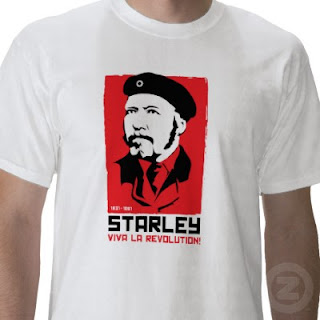I took the early morning train from Kenilworth back to Coventry today. I went straight to my time machine, disguised as a huge wooden crate in a currently empty warehouse. I didn’t bother to get a hotel, for I’m only staying the day. I left my luggage there and changed into my black frock coat and top hat I had been storing in the machine just for this occasion. I have to attend a funeral today.
 |
| James Starley |
As is the fashion of the day, the funeral was held four days later. The mood of Coventry is subdued. Many mourn the loss, while the more cynical wonder what the loss of the brilliant James Starley will mean to this town. Hundreds lined the street to watch the passing funeral procession, as four black horses pulled the long dark hearse.
I had a devil of a time squeezing into the church where the memorial service was held. The speaker unfolded the rags to riches story of Coventry’s favorite son. James Starley was born on a farm in Sussex in 1830. He however had an inventive mind that loved to tinker. In another age he would have died a farmer who had built a better mousetrap (which young Starley apparently did with an umbrella rib and a willow branch) but this is the industrial age and it needs engineering geniuses.
Starley ran away as a teenager to London and got a job as a gardener. In his spare time he tinkered with watches and gadgets. He even fixed and improved his employer, John Penn’s, expensive sewing machine. Penn introduced him to Josiah Turner, a partner of Newton, Wilson and Company who had manufactured his sewing machine. Turner got Starley a job at the factory, until he discovered the young man was building his own vastly improved sewing machine. Turner talked him into starting their own company in Coventry in 1861.
 |
| James Starley's "Queen of Hearts" Sewing Machine |
 |
| Velocipede aka Bone-Shaker |
 |
| Penny-Farthing bicycle |
 |
| Why there was a need for the Safety Bicycle |
 |
| James Starley on his "Salvo" bicycle |
Fortunately his family will carry on the business. And in four years his nephew, James Kemp Starley, will finish his uncle’s dream, creating the Rover. This safety bicycle is the model we think of today as the bicycle. It will revolutionize bicycling by making it available to just about everyone from young ladies riding in the park to working-class men making deliveries or riding to work.
James Starley has been called the Father of the Bicycle Industry. He may not have invented the first bicycle, or the final version, but without all his innovations, James Kemp Starley may never have invented the safety bicycle--at least not in time for the 1890s, the Golden Age of the Bicycle.
 |
| The Rover Bicycle |
There is already talk of making a monument to James Starley. It will be very showy in true Victorian fashion. However I think the James Starley Building on the campus of Coventry University is a more fitting memorial to an inventive genius.
 |
| Starley Memorial erected 1884 |
James Starley’s story by legendary British Cyclist Horace William Bartleet
More about James Starley’s Sewing Machines
Penny Farthings On the Road
Apparently in the future, brave men will still ride Penny-Farthings to impress ladies
 |
| Normally I don't put advertisements in my blog, but this was too good to ignore. Available at Zazzle |




No comments:
Post a Comment
Due to bots sticking ads into the comments I am now forced to moderate. Differing opinions are welcomed. This is history, which is the surviving written record, which may or may not be accurate. I will even allow comments pushing other books or websites as long as they are relevant.